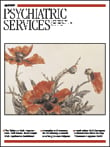Elimination of Seclusion and Restraint: A Reasonable Goal?
To the Editor: I am writing in regard to the special section on seclusion and restraint in the September 2005 issue. The assumption that seclusion and restraint can be "ultimately eliminated" from psychiatric practice to "improve the quality of people's lives," a proposition highlighted in the articles in the special section, is laudable in idealism but lacking in clinical reality.
Smith and colleagues' (
1 ) findings of markedly reduced use of seclusion and restraint in the Pennsylvania state hospital system should be viewed in light of clinical realities, including the increased use of PRN medications and the enormous transinstitutionalization of aggressive persons with serious mental illness to prisons where seclusion and restraint are much more frequent and damaging to patients than in hospitals.
The fact that the rate of staff injuries was not reduced in the Pennsylvania state hospital system despite a marked reduction in the use of seclusion and restraint suggests that staff security did not improve with decreased use of these procedures and that aggressive episodes did not materially change. Other hospitals also have reported failure to reduce the incidence of aggression when using similar modes of verbal communication aimed at "talking down" and debriefing patients displaying aggressive behavior (
2,
3,
4 ). Increases in the rate of aggression and injuries with verbal interactions are likely, given the contingent social reinforcement that is associated with the enhanced staff engagement, attention, and solicitude characteristic of these interventions.
In California where hospitals are mandated to implement a less restrictive, recovery model of care, a discouraging increase has been noted in aggression toward patients and staff. Atascadero has seen a 66 percent increase in aggressive acts in the last two years. During the same period, aggressive acts at Metropolitan State Hospital in Los Angeles County have increased by 50 percent. When state mental health systems use the rationale that a "recovery" and "empowerment" model of care reduces the need for seclusion and restraint, supervision, and security, dangerous behavior may increase because staff feel more vulnerable and are intimidated by some patients who exploit the new policies.
Still relevant today are the findings and recommendations of the American Psychiatric Association's task force on seclusion and restraint (
3 ), which highlighted the nonaversive use of behavior therapies, such as overcorrection, contingent observation, required relaxation, reinforcement of appropriate behavior, and positive programming. Use of a time-out area that offers time-limited privacy away from the location where aggression occurred has been shown to be effective in 74 percent of episodes (
4 ).
The special section in the September issue offers further evidence, already well-documented in the literature, that the use and abuse of seclusion and restraint can be reduced by administrative policies, leadership, and monitoring as well as by positive programming of planned and scheduled activities and educational programs for staff. However, to press for elimination of seclusion and restraint and its more effective and humanistic derivatives from applied behavior analysis is fatuous. Ideological straitjackets have failed many times in the history of psychiatry, and it would be regrettable if polemics replace sound clinical judgment and empirical evaluation based on the full picture of management of assaultive behavior.

